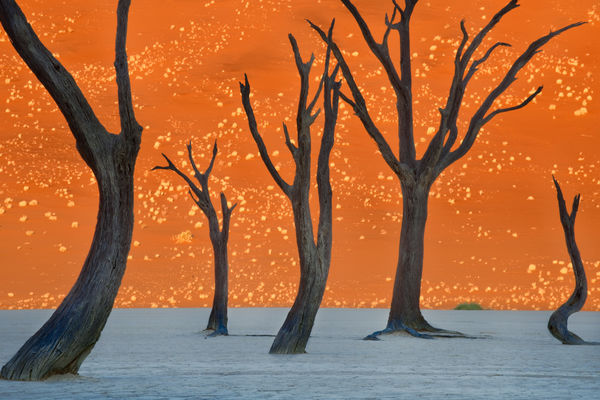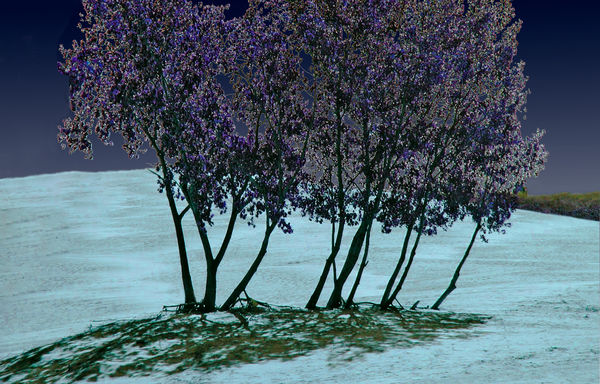Monthly Masters' Critique - August 2019 -Frans Lanting's "Ghost Trees"
Aug 1, 2019 10:39:27 #
Introduction
It's about time to discuss a Modern Master. This month we'll look at Frans Lanting, who has been hailed as one of the great photographers of our time. His influential work appears in books, magazines, and exhibitions around the world. Born in Rotterdam, the Netherlands, he earned a master’s degree in economics then moved to the United States to study environmental planning. For three decades he has documented wildlife from the Amazon to Antarctica to promote understanding about the Earth and its natural history through images that convey a passion for nature and a sense of wonder and concern about our living planet. Lanting’s work has been commissioned frequently by National Geographic, where he served as a Photographer-in-Residence. He has an international award named after him, a bit unusual for a photographer yet alive. Some of his talks are available online as TED talks (link below), and are pretty interesting.
Below is one of his most famous photos. You've probably run across it or one of the countless "copies" created by photographers who have sought to re-create it. “Ghost Trees, Namibia” made this location an iconic destination for landscape photographers. When it was first published, there was considerable discussion about its resemblance to a painting. In the linked articles, Lanting explains both his shooting technique and his rather minimal processing, and how these created the effect that viewers found so arresting. Study this image, and share your thoughts about it.
Some Questions to Spur Your Thinking
1. What do you think of the composition? The framing? The colors? The use of light? Would you want this image on your wall? Why or why not?
2. Given that little post processing was done here, what do you think makes this image look more like a painting than most photographs?
3. One of the characteristics that critics mention most often with this image is its graphic nature. Images with strong graphic impact seem to suggest traditional art to us either consciously or subconsciously. Have you made images that rely heavily on graphic impact? If so, please share one, and tell us a bit about how you did it, in terms of capture and/or processing.
4. In this and other of Lanting’s work, his goals always include his concern about the safety and protection of the earth and its creatures. Do you agree with him about outdoor photography’s responsibility to the planet? Why or why not? Have you ever taken actions in behalf of protecting some environment, plant or animal that you feel strongly about? If so, we hope you’ll share your experience.
5. How do you feel about the tendency of landscape photographers in particular to seek out the exact locations/conditions/angles/lighting to create their own versions of iconic photos? Is this a form of hero worship? A necessary step in learning mastery? A form of intellectual theft? Discuss your thoughts.
Links for Study
http://lanting.com/
https://en.wikipedia.org/wiki/Frans_Lanting
https://www.nationalgeographic.com/magazine/2011/06/frans-lanting-behind-the-photo/
https://www.ted.com/speakers/frans_lanting
https://www.creativelive.com/blog/frans-lanting-nature-photographer/
http://lanting.com/lifetime-achievement-award-goes-to-frans-lanting/
https://www.outdoorphotographer.com/pro-perspectives/frans-lanting/ghost-trees-namibia/
http://thephotosociety.org/member/frans-lanting/
It's about time to discuss a Modern Master. This month we'll look at Frans Lanting, who has been hailed as one of the great photographers of our time. His influential work appears in books, magazines, and exhibitions around the world. Born in Rotterdam, the Netherlands, he earned a master’s degree in economics then moved to the United States to study environmental planning. For three decades he has documented wildlife from the Amazon to Antarctica to promote understanding about the Earth and its natural history through images that convey a passion for nature and a sense of wonder and concern about our living planet. Lanting’s work has been commissioned frequently by National Geographic, where he served as a Photographer-in-Residence. He has an international award named after him, a bit unusual for a photographer yet alive. Some of his talks are available online as TED talks (link below), and are pretty interesting.
Below is one of his most famous photos. You've probably run across it or one of the countless "copies" created by photographers who have sought to re-create it. “Ghost Trees, Namibia” made this location an iconic destination for landscape photographers. When it was first published, there was considerable discussion about its resemblance to a painting. In the linked articles, Lanting explains both his shooting technique and his rather minimal processing, and how these created the effect that viewers found so arresting. Study this image, and share your thoughts about it.
Some Questions to Spur Your Thinking
1. What do you think of the composition? The framing? The colors? The use of light? Would you want this image on your wall? Why or why not?
2. Given that little post processing was done here, what do you think makes this image look more like a painting than most photographs?
3. One of the characteristics that critics mention most often with this image is its graphic nature. Images with strong graphic impact seem to suggest traditional art to us either consciously or subconsciously. Have you made images that rely heavily on graphic impact? If so, please share one, and tell us a bit about how you did it, in terms of capture and/or processing.
4. In this and other of Lanting’s work, his goals always include his concern about the safety and protection of the earth and its creatures. Do you agree with him about outdoor photography’s responsibility to the planet? Why or why not? Have you ever taken actions in behalf of protecting some environment, plant or animal that you feel strongly about? If so, we hope you’ll share your experience.
5. How do you feel about the tendency of landscape photographers in particular to seek out the exact locations/conditions/angles/lighting to create their own versions of iconic photos? Is this a form of hero worship? A necessary step in learning mastery? A form of intellectual theft? Discuss your thoughts.
Links for Study
http://lanting.com/
https://en.wikipedia.org/wiki/Frans_Lanting
https://www.nationalgeographic.com/magazine/2011/06/frans-lanting-behind-the-photo/
https://www.ted.com/speakers/frans_lanting
https://www.creativelive.com/blog/frans-lanting-nature-photographer/
http://lanting.com/lifetime-achievement-award-goes-to-frans-lanting/
https://www.outdoorphotographer.com/pro-perspectives/frans-lanting/ghost-trees-namibia/
http://thephotosociety.org/member/frans-lanting/
Aug 1, 2019 14:59:52 #
What strikes me about this marvelous photo is the mind of the photographer. Like many great artists, he saw something (trip to the Nabib) that inspired him to work at (come back for the light he envisioned as a possibility) capturing an idea along the lines of his main interest (the power of nature). If you want a great photo, have a unique way of looking at the main thrust of an idea you harbor. Good photos of course just fine for their uses.
Those that copy him, to my mind, contribute nothing much to great photography, but might learn something if that is their goal (and never show the photo experiments unless they move away quite a bit from the Lanting).
My trees photo, strangely enough along the same idea as Lanting's, is very different, another way of feeling the hidden power yet fragility of nature—and us humans.
Those that copy him, to my mind, contribute nothing much to great photography, but might learn something if that is their goal (and never show the photo experiments unless they move away quite a bit from the Lanting).
My trees photo, strangely enough along the same idea as Lanting's, is very different, another way of feeling the hidden power yet fragility of nature—and us humans.
Aug 2, 2019 09:32:01 #
artBob wrote:
What strikes me about this marvelous photo is the ... (show quote)
Thanks for sharing your thoughts and an interesting image. I totally agree that copying others' work contributes little, but instead can teach us much, as long as we don't get confused about what it is that we're accomplishing. If I were at this incredible scene, I am sure I'd try to take one as much like Lanting's as possible, just to learn from the experience. But I wouldn't be posting it for show or sale because it would only be my emulation of his art.
Aug 14, 2019 14:53:13 #
Ghost Trees to my eye looks more like an example of graphic art rather than photographic art, and my mind automatically compares it to other, more complete examples of graphic art. I would have the same problem with a photo that was deliberately intended to have a surreal look. We already have surreal art and it seems somehow inappropriate for photography to try to emulate styles that are obviously better rendered by the more synthetic techniques of graphic art.
Having said that, it's the graphic look that makes this shot as noticeable and as memorable as it is, and in that sense I would classify it as a successful photograph. There will always be room for photos that have strong echoes of other styles such as graphic, surreal etc. I think the problem I have with this one is that it looks more graphic than photographic.
I see that Ghost Trees isn't representative of his photographic style, which is more traditional. In response to question 4 I would say that any photographer or artist that does a good job of capturing nature is doing their bit to protect it. Good photos of nature remind us of how precious it is and how worth preserving it is. I hope magazines like National Geographic realise that they are in an ideal position to remind the general public of the importance of preserving nature.
Having said that, it's the graphic look that makes this shot as noticeable and as memorable as it is, and in that sense I would classify it as a successful photograph. There will always be room for photos that have strong echoes of other styles such as graphic, surreal etc. I think the problem I have with this one is that it looks more graphic than photographic.
I see that Ghost Trees isn't representative of his photographic style, which is more traditional. In response to question 4 I would say that any photographer or artist that does a good job of capturing nature is doing their bit to protect it. Good photos of nature remind us of how precious it is and how worth preserving it is. I hope magazines like National Geographic realise that they are in an ideal position to remind the general public of the importance of preserving nature.
Aug 14, 2019 15:05:36 #
R.G. wrote:
Ghost Trees to my eye looks more like an example o... (show quote)
The graphic nature of the image is, for me, what makes it so striking. I too noticed that Lanting doesn't do a lot similar work. And he explained the "how" quite precisely. How it came out looking as it does is a bit of an anomaly to me, but I have taken anomalous photos before myself, though none turned iconic like this one.
I echo your sentiments about the immense value of our world and its creatures, and your hope that photography can contribute to a better sense of conservation.
If you want to reply, then register here. Registration is free and your account is created instantly, so you can post right away.




